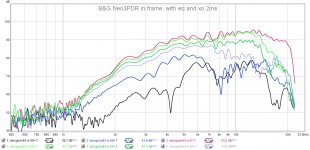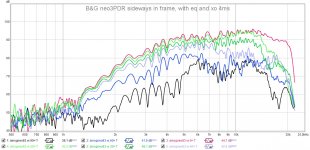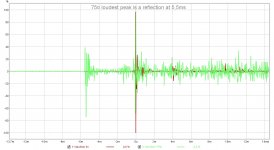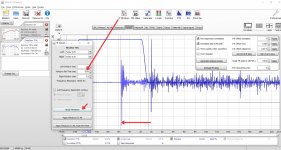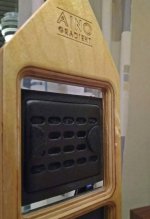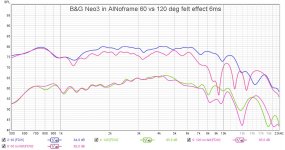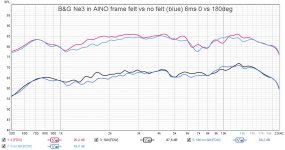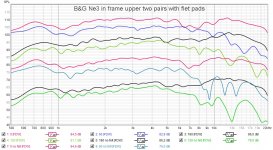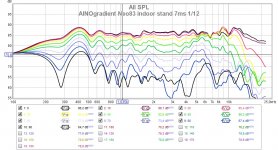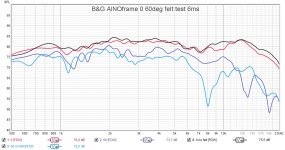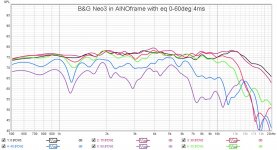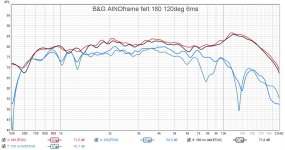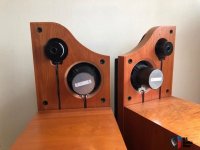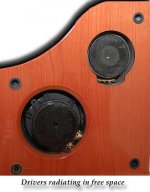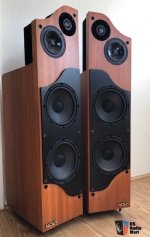Here are my measurements, 0 vs 90 deg difference is 20dB when response is pure dipole at 2kHz. OllBoll's measurements show only 10dB attenuation at 90¤. Measurement distance 1m roughly.
I use the Neo3 90deg turned, so response above 10khz suffers. On the other hand I get better vertical dispersion. The driver is mounted on 8mm thick plywood frame which makes problems 6-8kHz
I use the Neo3 90deg turned, so response above 10khz suffers. On the other hand I get better vertical dispersion. The driver is mounted on 8mm thick plywood frame which makes problems 6-8kHz
Attachments
Last edited:
OllBoll, please check impulse responses of your measurements! REW automatically sets measurement reference t=0 to the loudest sound which sometimes is reflected and delayed several ms from first peak.
In this example mistake occurs first at 75deg, the 5,6ms dealyed reflection is louder! Second pics shows how to correct it (apply only for that measurement!)
In this example mistake occurs first at 75deg, the 5,6ms dealyed reflection is louder! Second pics shows how to correct it (apply only for that measurement!)
Attachments
You are right that I probably had a bit too long gating so here is the same measurements with some shorter gatings:
But yeah you are right that the 60-90 should probably be lower, I might not have had the angles perfectly and with the mic distance of ~ 50 cm and measuring in a room that will probably also hide some of the null.
And on 90-180. This is two of the tweeters glued back to back so 90-180 is same as 0-90.
I think the alternatives to a waveguide or the neo 3 (or similar amt) are the following:
1. peerless OC16SC Back to back
(the smallest available! Dipollength is about 3,1 cm. The Membrane "bafflewidth" ratio is something like 1 to 3. So the dipoldip is not that deep) Or should be similar to the Peerless-Tweeter above but with smaller dip and the dip is probably 1khz higher.
2.peerless OC25SC Back to Back
(It is one of the best tweeter regarding the ratio Membrane to bafflewidth. Around 1 to 2,5.) Probably the dip is not visible. Its worth a try.
3. The smallest cone we can get. Something like the Peerless TC5.
(If the backside is attenuated 2-3db, its ok. So how behaves the backside radiation with these little drivers).
Best regards, Tomas
Why the ration of membrane to bafflewidth matters?
See here: Dipolplus - Alles über offene Schallwände
Generally till a ration 1 to 2 you dont see a dip. This is the reason why the neo 3 vertically positioned gives a better dispersion without a dip:
The size of the neo 3 is:
6,7cm*8,9cm.
the membran in the neo 3 has...
1,65cm *4,9cm.
We get a Ratio of
Horizontally: 1,65 to 6,7 = like 1 to 4. -> with a big dip
Vertically:. 4,9 to 8,9 = better then 1 to 2 -> without a big dip
It is interesting the jahuzi had put a small felt ot the sides of the neo 3. The membrane is still the same. But for a the half of the openings the ration is 1 to 2 and for the other half it is 1to3. The effect of the dipolewidth smears off.
I think we can see the same effect with the tweeter of OllBoll because the membrane is not flat. But the ratio is still to high, woth the tweeter fromm ollboll
See here: Dipolplus - Alles über offene Schallwände
Generally till a ration 1 to 2 you dont see a dip. This is the reason why the neo 3 vertically positioned gives a better dispersion without a dip:
The size of the neo 3 is:
6,7cm*8,9cm.
the membran in the neo 3 has...
1,65cm *4,9cm.
We get a Ratio of
Horizontally: 1,65 to 6,7 = like 1 to 4. -> with a big dip
Vertically:. 4,9 to 8,9 = better then 1 to 2 -> without a big dip
It is interesting the jahuzi had put a small felt ot the sides of the neo 3. The membrane is still the same. But for a the half of the openings the ration is 1 to 2 and for the other half it is 1to3. The effect of the dipolewidth smears off.
I think we can see the same effect with the tweeter of OllBoll because the membrane is not flat. But the ratio is still to high, woth the tweeter fromm ollboll
Tou,
i have been thinking about this same issue relative widening of baffle with reduced radiating area. I can see that effect in measurements, but as well some other aspects are better. My hearing is bad above 6-8kHz, but I think that I can hear the difference too.
I'll hope to find time on Wednesday to do proper new measurements!
i have been thinking about this same issue relative widening of baffle with reduced radiating area. I can see that effect in measurements, but as well some other aspects are better. My hearing is bad above 6-8kHz, but I think that I can hear the difference too.
I'll hope to find time on Wednesday to do proper new measurements!
If I equalize the front response to somewhat linear, both look like this:
What I still like about the response:
I have tried to keep the colors and the division according to your VIFA diagram. Does the VIFA have some kind of diffusor in front of the dome?
Even if the backside response of the FRS5X rolls off above 4 kHz, the response to the side will stay inside a nice dipole 8 for the front radiation. If I think about it: To me the balance between front and rear is less important than the well reduced radiation to the side.
For the TC5:
The TC5 is not so open on the backside, so i think the TC5 will not operate better then the frs5x on the backside.
The only advantage could be that it works probably at a higher frequency range, because of the smaller cone and backside. I think it could work from 2,5 khz to 6,5 khz. After this we get some disturbance on the backside (probably still ok till 8khz).
But in comperasion to the frs5x we can get more HF in the room:
http://www.loudspeakerdatabase.com/...5FC02-04_(Frequency_response_+_Impedance).png
https://www.visaton.de/sites/default/files/dd_product/frs5x_rd.gif
Nevertheless the HF with the FRS5x on the backside is attenauted from 4khz more or less 6db-9db
So with the TC5 if similar it should be attenauted the same or more from 5-6khz. And this is probably to much! (3db-6db could be ok)
Last edited:
Tou,
i have been thinking about this same issue relative widening of baffle with reduced radiating area. I can see that effect in measurements, but as well some other aspects are better. My hearing is bad above 6-8kHz, but I think that I can hear the difference too.
I'll hope to find time on Wednesday to do proper new measurements!
Hi Jahuzi,
this thread, rudolf's website and your findings with the neo3 helped me much to get to this solution. If we want to compare it correctly we have to count in the the size of your woodframe!
I will as well make some clearer estimates for the OC16 and the OC25 (i still dont have them):
First as reference the neo 3 and the OX20:
The size of the neo 3 is (nude, without woodframe):
6,7cm*8,9cm.
with the membran
1,65cm *4,9cm.
We get a Ratio of
Horizontally: 1,65 to 6,7 = 1 to 4
Vertically:. 4,9 to 8,9 = 1 to 1,8
Jahuzi, What is the size of your frame on the sides? If 2 cm:
This would make in your configuration: Vertically 4,9 to 12,9 = 1 to 2,6
and you get: https://www.diyaudio.com/forums/att...ipole-tweeters-neo3pdr-sidew-0-90-4ms-148-jpg
With Pads on both sides you smear it up to:
50% 1 to 2,6
50% 1 to 4,3
Could you send us a link to the measurements with pads?
OC20SC14 from OllBoll:
Size:
33 mm wide
9,5 mm smallest depth
16 mm biggest depth
24 mm effective cone diameter (membrane)
Resulting dipole bafflewidth:
Smallest 71mm
Biggest 97mm
We get a Ratio of
Smallest 1 to 2,9
Biggest 1 to 4
The resulting dispersion:
https://www.diyaudio.com/forums/att...ivity-dipole-tweeters-oc20sc14-4ms-gating-png
After this i will go the other OC16 and OC25....
Now the OC16 and OC25:
OC16SC:
Size:
26 mm wide
9 mm smallest depth
13 mm biggest depth
20 mm effective cone diameter (membrane)
Resulting dipole bafflewidth:
Smallest 62mm
Biggest 78mm
We get a Ratio of
Smallest 1 to 3,1
Biggest 1 to 3,9
Now the nice OC25SC:
Size:
41 mm wide
10 mm smallest depth
17 mm biggest depth (probably)
30 mm effective cone diameter (membrane)
Resulting dipole bafflewidth:
Smallest 81mm
Biggest 109mm
We get a Ratio of
Smallest 1 to 2,7
Biggest 1 to 3,6
--------------------------------------
So all in all the best Dome-Tweeter (Back to Back) solution should deliver the OC25SC. If needed the dip could even be smeared by a good baffle shape.
OC16SC:
Size:
26 mm wide
9 mm smallest depth
13 mm biggest depth
20 mm effective cone diameter (membrane)
Resulting dipole bafflewidth:
Smallest 62mm
Biggest 78mm
We get a Ratio of
Smallest 1 to 3,1
Biggest 1 to 3,9
Now the nice OC25SC:
Size:
41 mm wide
10 mm smallest depth
17 mm biggest depth (probably)
30 mm effective cone diameter (membrane)
Resulting dipole bafflewidth:
Smallest 81mm
Biggest 109mm
We get a Ratio of
Smallest 1 to 2,7
Biggest 1 to 3,6
--------------------------------------
So all in all the best Dome-Tweeter (Back to Back) solution should deliver the OC25SC. If needed the dip could even be smeared by a good baffle shape.
Last edited:
454Casull,
i hope i understand what you mean. I have made for me a calculation for a comperasion between
radian lt2 and neo3. Its clear that the radian lt2 is smaller but on the other hand you need to cross higher. Ihave looked at which frequency the first 0 offaxis at 80, 70, 60 and 45 degree is (for Mtm configuration). And you have to take in mind that if you cross the radian @ 3khz it is like a cross of the neo3 @2-2,2khz. The result showed me that you can get better result with the neo3 then with the lt2 Radian.
But with the tweeter there are other solutions available when it comes to c-c. For example you could use the oc25sc with four frs5x around them. Its like mmtmm. Because of the round baffle of the frs5x you can put them exactly side by side.
If you use xdir you can, that that you can cross with very good vertical pattern with the oc25.
If you want less distortion or a lower frequency for the crossover i recommend amt's for dipole. I think it is very difficult to use a tweeter with waveguide if you want a small c-c distance.
i hope i understand what you mean. I have made for me a calculation for a comperasion between
radian lt2 and neo3. Its clear that the radian lt2 is smaller but on the other hand you need to cross higher. Ihave looked at which frequency the first 0 offaxis at 80, 70, 60 and 45 degree is (for Mtm configuration). And you have to take in mind that if you cross the radian @ 3khz it is like a cross of the neo3 @2-2,2khz. The result showed me that you can get better result with the neo3 then with the lt2 Radian.
But with the tweeter there are other solutions available when it comes to c-c. For example you could use the oc25sc with four frs5x around them. Its like mmtmm. Because of the round baffle of the frs5x you can put them exactly side by side.
If you use xdir you can, that that you can cross with very good vertical pattern with the oc25.
If you want less distortion or a lower frequency for the crossover i recommend amt's for dipole. I think it is very difficult to use a tweeter with waveguide if you want a small c-c distance.
I think the alternatives to a waveguide or the neo 3 (or similar amt) are the following:
1. peerless OC16SC Back to back
(the smallest available! Dipollength is about 3,1 cm. The Membrane "bafflewidth" ratio is something like 1 to 3. So the dipoldip is not that deep) Or should be similar to the Peerless-Tweeter above but with smaller dip and the dip is probably 1khz higher.
2.peerless OC25SC Back to Back
(It is one of the best tweeter regarding the ratio Membrane to bafflewidth. Around 1 to 2,5.) Probably the dip is not visible. Its worth a try.
3. The smallest cone we can get. Something like the Peerless TC5.
(If the backside is attenuated 2-3db, its ok. So how behaves the backside radiation with these little drivers).
Best regards, Tomas
Another compact 1" dome tweeter you might consider is the LaVoce TN100.70
Lavoce TN100.70 1" Soft Dome Neodymium Tweeter 8 Ohm
It has a little bit better low end extension/performance than the Peerless OC25SC but costs about the same $8 each.
Thank you, these are interesting, too.
LaVoce TN100.70:
Size (did not found exact size in the pictures, so ~):
38 mm wide
~11 mm smallest depth
~15 mm biggest depth (probably)
~19 mm effective cone diameter (membrane)
Resulting dipole bafflewidth:
Smallest 82mm
Biggest 98mm
We get a Ratio of
Smallest 1 to 4,3
Biggest 1 to 5,1
-> The Effective cone diameter is to small in relation to the size of the tweeter, therefore you get a deeper dip.
So far we can get the best results with:
AMTs: Neo3 or alternatives (LT2 Radian,....)
Waveguides: for example XT25 + WG 300
Dome: Peerless OC25SC (Dome with the best ratio effective cone surface to bafflewidth if back to back)
For the Peerless we still need measurements. If somebody find another dome in very small package we can take a look on the ratio (effective cone surface to bafflewidth if back to back).
LaVoce TN100.70:
Size (did not found exact size in the pictures, so ~):
38 mm wide
~11 mm smallest depth
~15 mm biggest depth (probably)
~19 mm effective cone diameter (membrane)
Resulting dipole bafflewidth:
Smallest 82mm
Biggest 98mm
We get a Ratio of
Smallest 1 to 4,3
Biggest 1 to 5,1
-> The Effective cone diameter is to small in relation to the size of the tweeter, therefore you get a deeper dip.
So far we can get the best results with:
AMTs: Neo3 or alternatives (LT2 Radian,....)
Waveguides: for example XT25 + WG 300
Dome: Peerless OC25SC (Dome with the best ratio effective cone surface to bafflewidth if back to back)
For the Peerless we still need measurements. If somebody find another dome in very small package we can take a look on the ratio (effective cone surface to bafflewidth if back to back).
Have you seen these measurements of the OC25SC at HiFiCompass?
Vifa OC25SC65-04 | HiFiCompass
With Fs around 1500Hz, it is not all that surprising that distortion rises below 3kHz and whether used as a dipole or not that is about the lower limit of operation. Even above 3kHz the distortion performance is only slightly better than a Neo3/GRS PT2522 AND now you need to find a midrange that can operate as a dipole up to 3kHz. Other than a planar like the new GRS units (B&G copies), there aren't too many that can do that well! On the plus side, the OC25SC is quite sensitive.
Here is the distortion plot from HiFiCompass:

For only a modest increase in price ($30 vs $16) you can just use a PT2522 and get a real dipole tweeter with relatively good performance. Saving $15 per speaker is not really getting you much.
Vifa OC25SC65-04 | HiFiCompass
With Fs around 1500Hz, it is not all that surprising that distortion rises below 3kHz and whether used as a dipole or not that is about the lower limit of operation. Even above 3kHz the distortion performance is only slightly better than a Neo3/GRS PT2522 AND now you need to find a midrange that can operate as a dipole up to 3kHz. Other than a planar like the new GRS units (B&G copies), there aren't too many that can do that well! On the plus side, the OC25SC is quite sensitive.
Here is the distortion plot from HiFiCompass:

For only a modest increase in price ($30 vs $16) you can just use a PT2522 and get a real dipole tweeter with relatively good performance. Saving $15 per speaker is not really getting you much.
Hi Jahuzi,
this thread, rudolf's website and your findings with the neo3 helped me much to get to this solution. If we want to compare it correctly we have to count in the the size of your woodframe!
I will as well make some clearer estimates for the OC16 and the OC25 (i still dont have them):
First as reference the neo 3 and the OX20:
The size of the neo 3 is (nude, without woodframe):
6,7cm*8,9cm.
with the membran
1,65cm *4,9cm.
We get a Ratio of
Horizontally: 1,65 to 6,7 = 1 to 4
Vertically:. 4,9 to 8,9 = 1 to 1,8
Jahuzi, What is the size of your frame on the sides? If 2 cm:
This would make in your configuration: Vertically 4,9 to 12,9 = 1 to 2,6
and you get: https://www.diyaudio.com/forums/att...ipole-tweeters-neo3pdr-sidew-0-90-4ms-148-jpg
With Pads on both sides you smear it up to:
50% 1 to 2,6
50% 1 to 4,3
Could you send us a link to the measurements with pads?
OC20SC14 from OllBoll:
Size:
33 mm wide
9,5 mm smallest depth
16 mm biggest depth
24 mm effective cone diameter (membrane)
Resulting dipole bafflewidth:
Smallest 71mm
Biggest 97mm
We get a Ratio of
Smallest 1 to 2,9
Biggest 1 to 4
The resulting dispersion:
https://www.diyaudio.com/forums/att...ivity-dipole-tweeters-oc20sc14-4ms-gating-png
After this i will go the other OC16 and OC25....
Sry, i had made a mistake. I didn't count the depth of the neo3. Again:
The size of the neo 3 is (nude, without woodframe):
6,7cm*8,9cm.
depth is 1,1cm
Resulting baffle witdh as dipol:
8,9cm*11,1cm
with the membran
1,65cm *4,9cm.
We get a Ratio of
Horizontally: 1,65 to 8,9 = 1 to 5,4
Vertically:. 4,9 to 11,1= 1 to 2,3
Jahuzi, What is the size of your frame on the sides? If 2 cm:
This would make in your configuration: Vertically 4,9 to 15,1= 1 to 3,1
and you get: https://www.diyaudio.com/forums/att...ipole-tweeters-neo3pdr-sidew-0-90-4ms-148-jpg
With Pads and in the wood frame on both sides you smear it up horizontally to:
50% 1 to 3,1
50% 1 to 5
Could you send us a link to the measurements with pads?
Soo if the Tweeter of OllBoll dont has a good dispersion like the neo 3 we sould take a exact look on how much of the biggest and how much of the smallest ratio we have there. Afterwards we can probably smear it up with the right baffle shape.
Last edited:
Have you seen these measurements of the OC25SC at HiFiCompass?
Vifa OC25SC65-04 | HiFiCompass
With Fs around 1500Hz, it is not all that surprising that distortion rises below 3kHz and whether used as a dipole or not that is about the lower limit of operation. Even above 3kHz the distortion performance is only slightly better than a Neo3/GRS PT2522 AND now you need to find a midrange that can operate as a dipole up to 3kHz. Other than a planar like the new GRS units (B&G copies), there aren't too many that can do that well! On the plus side, the OC25SC is quite sensitive.
Here is the distortion plot from HiFiCompass:
For only a modest increase in price ($30 vs $16) you can just use a PT2522 and get a real dipole tweeter with relatively good performance. Saving $15 per speaker is not really getting you much.
Yes, you are right. I think we should cross it over 3khz, too. You could try the frs5x 4 times around the oc25sc. They fit exactly together. Perfect dappolito if you want
i have opened a thread with possible midranges for dipol configuration. you can post there some ideas and polar plots if you have an additional idea for the low mid.
Personally i think the same as you. The neo3 is better. But nevertheless i look for alternatives for example with even dispersion vertical and horizontal.
Last edited:
Fist, I know that the frame and attachment of B&G Neo3PDR in AINOgradient is not perfect. Esthetics say that the drivers must be screwed on the backside. Physics tell that plywood frame must have decent thickness, 8mm on my case. This means that high frequencies will have diffractions that make frontal response and dispersion worse than the backside.
I put the Neo3 sideways, because the unit ha same height as Ne8's width, and I hoped that open area above and below the driver would help dipole action.
So, today I ran some freehand measurement of just the Neo3 tweeter, without any xo or eq. We can see that on-axis frontal response has dip around 8kHz because of frame interferences. The however get neutralized on power response, because typically for such interfeneces, response/spl shows minimal directivity. I have set 2.2dB peak eq however. Felt makes the radiating area a little narrower and helps remarkably at 60deg off-axis ( and of course or other off-axis angles as well, above 6kHz.
Most measurements in the web album are without felt pads on tweeter.
AINOgradient - Google Photos
I put the Neo3 sideways, because the unit ha same height as Ne8's width, and I hoped that open area above and below the driver would help dipole action.
So, today I ran some freehand measurement of just the Neo3 tweeter, without any xo or eq. We can see that on-axis frontal response has dip around 8kHz because of frame interferences. The however get neutralized on power response, because typically for such interfeneces, response/spl shows minimal directivity. I have set 2.2dB peak eq however. Felt makes the radiating area a little narrower and helps remarkably at 60deg off-axis ( and of course or other off-axis angles as well, above 6kHz.
Most measurements in the web album are without felt pads on tweeter.
AINOgradient - Google Photos
Attachments
Last edited:
Mistake in previous post! midrange was playing too!
In the morning I realized that midrange was playing too yesterday, that's why some changes were irrational (interferences)
New measurements and shown in a different way, now felt effect can be seen more clearly. Major effect is reducing the 8 and 13kHz interferences, 8kHz being naturally more meaningful! With felt this cavity effect is not harmful with eq, up to 45deg off-axis.
Dropout at 1,2kHz is first room reflection!
In the morning I realized that midrange was playing too yesterday, that's why some changes were irrational (interferences)
New measurements and shown in a different way, now felt effect can be seen more clearly. Major effect is reducing the 8 and 13kHz interferences, 8kHz being naturally more meaningful! With felt this cavity effect is not harmful with eq, up to 45deg off-axis.
Dropout at 1,2kHz is first room reflection!
Attachments
Last edited:
Hi Jahuzi, very nice! Thank you for the good measurements.
If i put the bafflesize (incl. Ainoframe) in edge and make a graph at 60 degrees one time with a membranwitdh of 50mm and one time with 30mm, we can see your results. The final response with felt is like 50% with a 50mm membran and 50% with a 30mm membrane. The biggest effect (regarding spl) is seen off-axis.
I have took again a look on the OC25SC with Edge. If we take them and make a (very thin) baffle shape like in the picture , we get a very nice On axis and Off axis response. The point is, that we smear the dip away.
, we get a very nice On axis and Off axis response. The point is, that we smear the dip away.

(The sharp corners goes to northwest, southwest, southeast, northeast)
If OllBoll is here with his OC20SC he could try this as well. But this should work!
If i put the bafflesize (incl. Ainoframe) in edge and make a graph at 60 degrees one time with a membranwitdh of 50mm and one time with 30mm, we can see your results. The final response with felt is like 50% with a 50mm membran and 50% with a 30mm membrane. The biggest effect (regarding spl) is seen off-axis.
I have took again a look on the OC25SC with Edge. If we take them and make a (very thin) baffle shape like in the picture

(The sharp corners goes to northwest, southwest, southeast, northeast)
If OllBoll is here with his OC20SC he could try this as well. But this should work!
Are NOLA tweeters really dipoles?
Apologies for dropping this question here out of the blue, but are these tweeters actually effective as dipoles?
These pics are of the NOLA Viper II Plus. I don't know the brand of tweeters.
Apologies for dropping this question here out of the blue, but are these tweeters actually effective as dipoles?
These pics are of the NOLA Viper II Plus. I don't know the brand of tweeters.
Attachments
Last edited:
- Home
- Loudspeakers
- Multi-Way
- On the directivity of dipole tweeters
